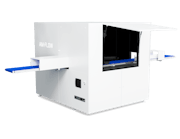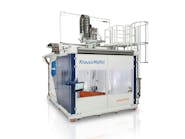
It could be said that Ken Bullivant edged his way into the plastics industry. Having graduated from the University of Maryland in 1964 with a degree in electrical engineering, he began working in minerals processing for the now-defunct Allis-Chalmers, a 30,000-employee company. Eventually, that experience led him to found Plastrac Inc. out of his home in 1995. Today, Plastrac is an international designer and manufacturer of disc-based gravimetric and volumetric blending equipment and materials loaders for plastics processing. Bullivant recently spoke with PMM correspondent Lisa Jo Lupo.
Having started out in a completely different industry, what brought you into plastics?
Bullivant: After graduation, I started working on minerals-processing systems. The only connection with the plastics industry is that industry, as well, is using gravimetric feeders for metering additives. I was working on all sorts of different things, controls and power and so forth, but I found that the controls and blending and things like that were the most interesting parts of it.
I went from there to a smaller company, then to a very small company, which was the forerunner of K-Tron. At the time they only had six employees, and I was the only engineer doing development work. So they had a weighing scale and we set out to develop a gravimetric feeder based on this weighing cell, which happened to be a pneumatic device. We launched a product there and soon made the transition to electronic weighing and controls, and we had the good fortune of coming up with the world's first digitally controlled, weigh-belt feeder. As a result of that, the company grew and grew, and a significant portion of the business was to the plastics compounding industry.
Then in 1993, K-Tron bought the German plastics company Colortonic, and I spent almost a year in Germany trying to help the engineers modernize the equipment with American-style electronics while still building on the excellent mechanical designs that they had.
What were you seeing in the industry that led to your decision to go out on your own?
Bullivant: I saw a major opportunity to design and manufacture equipment in the U.S. I was able to enhance disc-based feeding and blending and to be more responsive to U.S. customers, by sourcing parts and manufacturing equipment in the U.S. and by developing product innovations based on customer needs.
In 1995, due to difficult economic times, in Europe particularly, K-Tron had decided to sell Colortronic. That is the point when I decided that I would really like to pursue that business line — and since K-Tron had sold the business, it freed me from the noncompetition clause in my contract. What I had learned was the people had enormous respect for the performance and reliability of disc feeders that had been pioneered in Germany. But they wanted more — they wanted the gravimetric features and calibration, the ability to easily have multiple additives, the service and support you get with a U.S.-manufactured product, and the value that's possible by manufacturing in the U.S. So that really was the reason for founding Plastrac.
What do you see as the greatest points of differentiation for Plastrac that have contributed to your growth?
Bullivant: The whole focus of Plastrac was to capitalize on the quality and the advantages of the disc feeders but to fill in all the areas where it needed to be enhanced. Then focus on the blending market for injection molding, and the simple extrusion and blow-molding markets. So, to focus on that one business, we came up with a standardized, modular product line — modular mechanically and from the standpoint of the electronics and controls software.
By having a standardized product, we can be cost-effective because we're using the same parts in reasonably large quantities, and we confine our engineering work to adaptations and extensions to our standard product line. We're not in the business of selling engineering, because for a small business, it's too precious a commodity. If we see that our standard product can do a new job with only minor modifications or extensions, we say sure we'll do that and we won't even charge for the engineering because we won't do it if it's not something we can sell to other people in the industry. That way we guard our resources to always build and extend our own product line.
What in your experience made the disc feeder technology such a focus for Plastrac? Can you briefly discuss the importance of your level sensor innovation to this technology?
Bullivant: While working at K-Tron, I had over 20 patents in the feeding, blending and weighing of materials. When we started Plastrac, we patented the ability to automatically calibrate while running. We also developed a unique level-sensing vane switch that comes standard on our equipment and allows the ability to perform quick color changes by replacing our top castings without the need to remove any cables.
How have lead times changed over your time in the industry and what would you identify as the key to your success?
Bullivant: Lead times have shortened dramatically. If you are not able to deliver your product to the customer in short order, they will likely purchase equipment from another source. Our role has been to take a modular approach in the design of our mechanical and electronic systems. This allows us to inventory all of the components and subassemblies necessary to produce our systems in a timely manner. This enables us to make Just In Time manufacturing possible. It also allows us to meet our customers' needs for spare parts by having everything in stock and able to ship out the same day that they are ordered.
The key to our success is the fact that we're focused and we've concentrated on being able to do things fast. It seems that when you're selling our type of equipment people have the molding machine arriving at their plant and say, "Oh, I forgot we needed something to feed it!" So they call up and want outrageously quick delivery. We build all our modules up and have them on the shelf, and we can assemble a machine in as little as one day, if necessary. Because the equipment is U.S.-manufactured, all the parts are in stock in our plant.
We've had numerous occasions where a customer needs a part for a foreign-sourced machine and says, "Not only is the part outrageously priced, but I have to wait forever to get it. I'll just buy a new machine from you." So many bigger companies say we want everything to be profitable. Our philosophy is different. We want to give that customer no reason not to buy from us forever. Also, when we say modular in electronics, it's not only so we can configure it to different versions, it's also so that no single part is outrageous in price.
Who would you identify as your closest competitors and in what ways do you make sure Plastrac stays ahead of the game?
Bullivant: Anyone making blending equipment technically is a competitor, but we tend not to focus on what anyone else is doing. Our focus is customer-centric, helping processors meet blending challenges, improve quality, save money and ramp up efficiency. If anything, we have, over time, looked at competing technologies and sought ways to offer better solutions. For instance, weigh batch blenders and augers were once standards in the industry, but we looked at other approaches in developing our systems. Another aspect of processing that we were ahead of was the use of micropellets. Our systems have long done a great job blending them. However, what drove increased customer acceptance and made the industry catch up was the cost of material, which also led to greater use of regrind.
What do you see as your greatest contribution to the industry? How would you like to be remembered?
Bullivant: I feel that you can manufacture world-class equipment in the U.S. We hope that our product is contributing to the efficiency of U.S. manufacturing by offering tremendous value as well as being world-class in performance. We've shown, at least on a small scale, that you can do great manufacturing here.
Lisa Jo Lupo, correspondent







